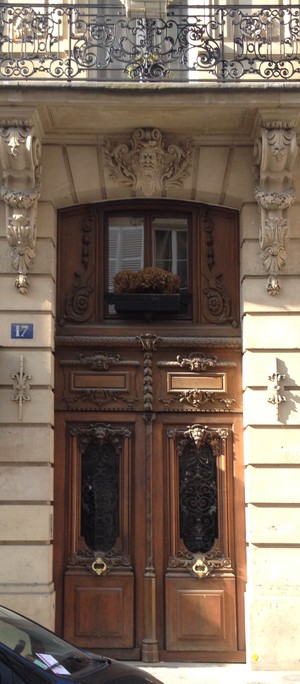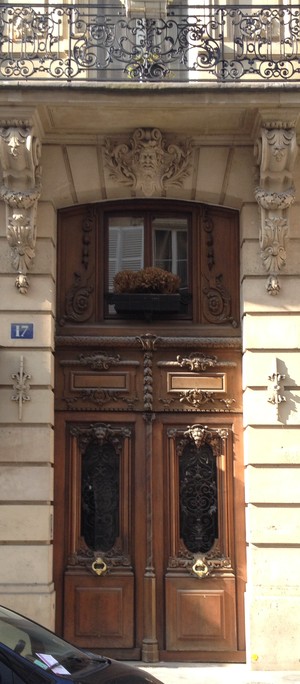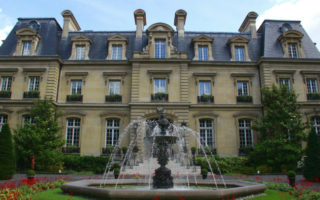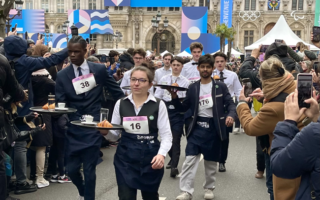Parisian doorways. Two Doors, One Morning

- SUBSCRIBE
- ALREADY SUBSCRIBED?
BECOME A BONJOUR PARIS MEMBER
Gain full access to our collection of over 5,000 articles and bring the City of Light into your life. Just 60 USD per year.
Find out why you should become a member here.
Sign in
Fill in your credentials below.
Doorways can be beautiful, some of them. Think of those elegant beauties in the apartment houses from the 1890s with marble brackets holding up a lintel overhead, below that a mascaron or sometimes a cartouche, the chestnut or oak of the double doors themselves, their glass armored in cast-iron grillwork with a sculpted head or maybe a pineapple or a bunch of grapes up top, their shiny door knobs or, better yet rings, catching the eye like birthmarks, the flinty threshold. Do they say Welcome, come in? More likely, I think, they say Look at me, and of course I do. Who wouldn’t? Perhaps if I ever lived on the other side of doors like these I would know what they really mean to say. As it is, my best guess is it’s How’s tricks? or in my case Wipe your feet.
Other doorways impress me, but I don’t find them lovable. They are simply grand and meant to be taken as impressive or imposing. Beautifully finished or plain, their great virtue, in the eyes of the original owner of the house, was to let the world admire him, or his money. They are wide, so broad in the beam, that a great carriage pulled by four slightly skittish horses can pass through with more than enough room to spare on the sides and so tall that the coachman sitting on the box of the carriage need not even think about taking off his top hat as he drives in or out.
You know as well as I, however, that many doors aren’t worth a first glance, let alone a second. Some were Plain Janes they day they were built and hung on their jambs, others have lost any beauty or allure they ever had because of neglect or bad luck, and some are nothing but ugly, yet could be had for practically nothing. These are as easy to ignore as the beauties and the big beasts are likely to grab you by the eyeballs.
But like Judy O’Grady and the Colonel’s Lady they have something in common. They are doors, the way in and the way out. I suspect that architects, builders and the people who hire them think of doors as a way to keep people and other unwanted elements out. My own feeling is that a door is a way to let me in. Perhaps I’ve said this before, so forgive me, but one of the first things I learned about doors in Paris was this: if it’s open, walk through or if it’s closed, not locked and nobody raises a hand to stop you, in you go.
Over the years, my attitude toward doors has led to some lovely discoveries, to some interesting moments, and to a very few mishaps, none requiring surgery, though once or twice a bandage was useful. The occasional brushes with criminal trespass, or an innocent desire to take a look, as I explained it to the angry man holding a hammer who accused me of intrusion illégale de propriété, were spaced so far apart that I tended not to think about them or take them much into consideration. That was the case for many years, but nothing lasts forever.
I am heading straight to nowhere in particular today, but a difficult puzzle is getting to me, so I think of a park I like in the Seventh. It’s called a garden and it does have flower beds, but best of all a little vegetable patch where teachers and parents show boys and girls real live carrots and onions and turnips growing right out of the ground—imagine that! A good place to deal with the puzzle at hand which is why do supermarkets in Paris and even the street markets that sell nothing but fresh produce offer only cooked beets? Franprix and Carrrefour sell them wrapped up and peeled. Considering how finicky the French are about food, this is strange and requires the kind of Zen peace of mind needed to assemble a Japanese bicycle.
But on the way I notice a doorway in a dumpy building across the street to my right. Doorway is probably too flowery. It’s an unappealing opening for a driveway, gates back. Ah, but now keep looking. Way beyond the big square hole in an ugly wall, there’s greenery, some objects that could be sculpture and what looks like a gazebo. What would you do? Exactly.
It’s a fairly large park in the middle of a Parisian block and I’ve never seen it before because the solid gates have always been closed when I passed. If you know how to read a map and are looking for it, it shows up pale green, but unlabeled. Two-thirds of it is a large lawn with shrubs of one kind or another around it. Off to the left, there’s a strip of grass separated from the main lawn by a typical dust-and-pebble footpath. What I saw from the street are a stele, a bell and what I think is called a lantern with a pagoda top all honoring Korean, and a few Vietnamese, martyrs to the faith. This is a very Catholic park: the gazebo has Regina Confessorum blazoned over its entry, and on the wall are the lists of those who died, going back to the seventeenth century, all duly certified as heaven-bound by Pope John Paul II and accompanied by a slightly doleful BVM who needs a dusting.
And so quiet. Not a sound from the street gets in here. The garden sides of the buildings, the headquarters of the overseas missions in Paris, are much more elegant, and much cleaner, than the sides facing the street. Too open to be a cloister, it is still a place I hope to come back to when I need to think about cooked beets or anything else where contemplation will help. But now is not that time, the beets having faded in my excitement over the hidden garden. And of course the gates are closed—and of course I don’t have the code to open them.
Some distance back from them over to my left I see a procession of Asians walking along the terrace next to the building. I figure they have had their tour, are being shown out, and I fall into step behind them, but they head into the dumpy building through which I entered and which is a lecture hall. I run for my life, a talk by a missionary on the beatitudes, or something, of seventeenth-century Korean martyrs looking a hell of a lot more baleful than a fate worse than death. No one else is around, I don’t see anyone near the two doors in the main building that look as if they may open, and the very tall wall behind the stele and bell leads into the back of a French government ministry: even if I could climb it, the results would be worse than the lecture on the persecuted Koreans.
I’m enjoying the problem, this is getting interesting, I could be here for a while—and then its anti-climax, a crash after a high. A small van that, come to think of it, was just parking when I wandered in though I hadn’t noticed it in the driveway, is driving up to the keypad. The rest is what you expect. Open Sesame, go van, exit Joe. The escape was too easy, but it is troubling that the odds I’ll ever get back into that garden are close enough to zero it’s not worth thinking about or looking for a dimwitted bookie.
If I were temperamental, no doubt I’d positively stamp my foot and say a bad word. Better just to walk it off. Despite its reputation as a beau quartier of Paris, a good deal of the Seventh Arrondissement is indistinguishable from any other part of Paris. Plenty of narrow streets, unsplendid cafes, run-of-the mill Haussmann-style buildings. The spectacular bits and pieces—is anything grander than the Place de Breteuil?—are scattered and some of the ancient mansions are in nondescript streets that could pass for tidy alleys.
But before the Seventh became part of Paris in the early nineteenth century and was called Le Faubourg, it was more rural than city slicker and had some splendid buildings, and I have just come up to one. I am taking its splendor on faith because like all hôtels particuliers of the late eighteenth century, especially in the wilds outside the Octroi, it has a formidable wall and all that is visible of the presumed mansion within is the top of the house, just barely. Its stables facing the street, if put on the market tomorrow, would probably bleed the average investment banker dry: horses used to live well.
The doorway is the imposing kind, tall and wide, but not lovely. Its double doors are carved—nothing extraordinary, off-the-shelf millwork—and painted a middling, rather pleasant blue. The right-hand door has a smaller passage door to let people in and out without committing to the considerable act of swinging open the whole works. You imagine that opening the double doors requires the effort of four men and a boy, or a strong electric motor, and a trumpet voluntary.
I know better than even to try the door handle: doorways on buildings like these do not yield to the likes of me, so I walk up and down on the sidewalk around the two sides not hemmed in by other buildings, wondering what’s inside. There are big trees in there and that means a garden which, I imagine, ought to be a treat to see. Then good fortune arrives in a small van, but not the same one which unknowingly let me in to and escape from my hidden garden of Korean martyrs just forty-five minutes ago. A man gets out, hauls some soil or mulch in bags out of the back, loads them on a hand truck, walks up to the passage door, taps it, it opens and he wheels the hand truck in.
And I am right behind him. Not for long. I have the door open maybe 30 centimetres when it pushes back, and very hard, against me, not because it closes automatically but because a very angry woman is telling me I can’t come in. I had noticed the video cameras mounted on the walls and I’m sure she saw me, was watching and, when I moved toward the door, she had already worked up a head of steam and hit the door running. Given that F = ma, I calculate that she, probably weighing in at fifty kilos, hit the door at about 50 k/h, yielding a force of… nearly enough to break my wrist.
But I don’t want to come in, Madame. Just take a look. “You can’t look. Go away.” She continues to push. The man with the hand truck and another, watching without much interest from a few metres behind her, don’t look like hired muscle, but there’s no doubt that if she asked for a little help, they would oblige. I wish her bonne journée, and retreat, certainly still on camera.
This is annoying. I saw just enough to know that the garden behind the double doors must be pretty if not gorgeous, enough to be sure enough, but not enough to know for sure. I didn’t even have the pleasure—or maybe the accomplishment—of actually trespassing since both my feet were on the sidewalk.

Two doors closed on me in one day. Closed forever too, I’m sure. On the way home, I pass a real beauty—varnished fruitwood, iron and brass grill over the glass, two mascarons, brackets under the lintel, brass handles—and decide to admire it from across the street. I take its picture and go cheerfully about my business.
More in Paris life


